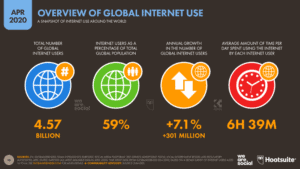Connectivity is essential for us to be united in mind, perception, and action. The connection allows energy to flow among people to act as one when they want someone to feel seen, heard, and valued.
Consider this scenario: a man in India, sits by a bridge, crying his heart out, unable to go home to his dying son. Only his faithful cellphone, clutched in his hand, pressed closely to his ear, offers him some comfort as he talks to his wife. Atul Yadav, a photographer with the Press Trust of India, captured the image of Rampukar Pandit, a migrant laborer as his face contorted with grief about his sick baby boy. His trip to Bihar from Delhi was on foot.
The pain-filled image went viral and attracted people to help the desperate, penniless man from as far as New York and California. Americans felt the connection.
Connectivity through the cellphone
In the midst of the pandemic, when social distancing is enforced, the mobile cellphone is a frontline tool –alleviates pain, offers words of comfort by a familiar voice, a source of vital information, a means to send some urgent cash to a distant family member caught in lockdown – and yes, imparts urgency to social media.
Yadav’s photograph illustrates the anguish of millions of migrant laborers in India who are desperate to get home to their families. After waiting in vain for the government to provide them with transport (belatedly some trains are now being laid on for them) they have embarked on astonishing odysseys, from cities all over the country, journeys that have left Indians transfixed and distressed
Unique mobile users grew by 128 million globally

As of April 2020, here are amazing statistics that highlight connectivity:
There are 5.16 billion unique mobile phone users in the world today, according to the latest data from GSMA Intelligence.
The total number of unique mobile users around the world grew by 128 million in the past 12 months.
Unique mobile users are currently growing at a rate of 2.5 percent per year. However, hundreds of millions of people have also upgraded from ‘feature’ phones to smartphones in the past 12 months.
The latest data from Ericsson show that the number of mobile subscriptions associated with smartphones now exceeds 6 billion, accounting for 73 percent of the mobile handsets in use around the world today.
Smartphone use is currently growing at an annual rate of 8 percent, with an average of more than 1 million new smartphones coming into use every day.
Cutting connectivity by social distancing, lockdowns, and shutdowns of basic service providers, schools, parks, museums, libraries, and schools, to name a few, have long-lasting dire mental health consequences to citizens in many countries. The longer the separation lasts, the greater the level of injury to all ages.
According to 2018 and 2019 student surveys from the American College Health Association (ACHA), about 60% of respondents felt “overwhelming” anxiety, while 40% experienced depression so severe they had difficulty functioning. A 2019 Pennsylvania State University study noted that demand for campus mental health services spiked by 30-40% during a period that saw only a 5% increase in enrollment.
Internet connectivity for most is through the use of a mobile phone. Our means of communication have changed; habits have shifted; our routine altered. These are the changes technology has brought to our society, which the different societal institutions have learned to adapt to. Yet, this problem of a damaged cellphone is oftentimes ignored in the hustle and bustle of things. All can feel hopelessly disconnected when no one cares.
Ruggedness, repairability, and technical support of mobile devices
It is often not the purchase price of the mobile device alone that matters, but the total life-cycle cost, including when a device is broken, lost, or damaged. The loss of income can be catastrophic to micro blockchain traders that are totally reliant on devices to facilitate the means of exchange needed for commerce to function.
The challenge in developing countries is the turn around time of repairing damaged handsets or devices that go out of service.
What services are required to re-commission damaged mobile phones, and in outlying areas, what service is in fact available? In an increasing blockchain world in countries like Kenya, this is a crucial service to allowing the continued functioning of a blockchain trading and payment service for many businesses to function.
Blockchain and mobile technology in developing nations – the impact of connectivity
Almost all of the countries in the developing world have skipped fixed-line infrastructure and leapfrogged directly onto a mobile technology platform. The rapid market penetration of mobile technology had entrenched mobile devices as the predominant form of communication in the developing world.
Dear Diary
I read a quote by 16-year old Elisha Owusu Akyaw, Africa’s Youngest Blockchain Entrepreneur. In a time when most of his peers were focused on school or social activities, he was developing a blockchain media business.
He said
”There is a lot to be done in the blockchain space in Africa. Identify the problems around you, fix the problem and you will have a winning project or product in your hands. Let’s all work together to bridge the gaps on the continent, educate the masses, and help the continent grow.”
This gave me hope for what I can do with blockchain applications in my country.
Not only do mobile phones help to create opportunities for small local businesses to network with a larger market than previously were able to, but they also strengthen social ties among communities and lessen the vast distances between groups of people. blockchain has also created a change
Mobile phones and in the way that local and international organizations do business making communication easier, quicker, and allow real-time transactions.
Here are a few key thoughts about the contribution of mobile phones blockchain apps in developing countries:
- How much could blockchain contribute to greater financial incomes and employment opportunities?
- With access to mobile phones, remote farms and rural health centers can be radically transformed on a blockchain platform
Access to cellphone technology is quickly reshaping the way individuals and communities manage their finances, monitor weather, engage with government, and earn a living, according to the recent World Bank Maximizing Mobile report.
The World Economic Forum has stated that by 2025, 10 percent of the global gross domestic product (GDP) will be stored on a blockchain and blockchain-related technologies. Finally, consider this: “It’s not our connectivity, but our connectedness which connects us.” – Dr. Kelly Page
Who among us will empathize with the man as he feels desperate about his circumstances? If you do, you have that connectedness. Let’s all hope that the blockchain connection will somehow be adopted throughout the globe and alleviate further suffering. And yes, keep your cellphones close for that urgent connectivity.





